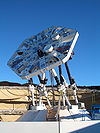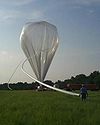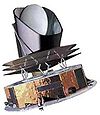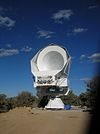- List of cosmic microwave background experiments
-
There have been a variety of experiments to measure the Cosmic microwave background (CMB) radiation anisotropies and polarization since its first observation in 1964 by Penzias and Wilson. These include a mix of ground-, balloon- and space-based receivers. The most notable of these are COBE, which first detected the temperature anisotropies of the CMB, and showed that it had a black body spectrum; DASI, which first detected the polarization signal from the CMB; CBI that made high-resolution observations and obtained the first E-mode polarization spectrum and WMAP, which has provided the best full-sky CMB maps to date. Planned future experiments include the Planck spacecraft, which aims to produce high-resolution all-sky maps of both the temperature anisotropies and polarization signals, and various ground-based experiments primarily intended to investigate small-scale anisotropies and trying to detect the polarization caused by gravitational waves in the early universe.
The design of cosmic microwave background experiments is a very challenging task. The greatest problems are the receivers, the telescope optics and the atmosphere. Many improved microwave amplifier technologies have been designed for microwave background applications. Some technologies used are HEMT, MMIC, SIS and bolometers. Experiments generally use elaborate cryogenic systems to keep the amplifiers cool. Often, experiments are interferometers which only measure the spatial fluctuations in signals on the sky, and are insensitive to the average 2.7 K background.
Another problem is the 1/f noise intrinsic to all detectors. Usually the experimental scan strategy is designed to minimize the effect of such noise. To minimize side lobes, microwave optics usually utilize elaborate lenses and feed horns. Finally, the atmosphere is an issue because water absorbs microwave radiation (a fact utilized in the operation of microwave ovens), it is rather difficult to observe the microwave background with ground-based instruments. CMB research therefore makes increasing use of air and space-borne experiments. Ground-based observations are usually made from dry, high altitude locations such as the Chilean Andes and the South Pole.
The list below consists of a partial list of past, current and planned CMB experiments. The name, start and end years of each experiment are given, followed by the basis of the experiment—whether space, balloon or ground based—and the location where appropriate. The frequency and amplifier technologies used are given, as is the main targets of the experiments.
Image Name Start End Basis Location Frequency (GHz) Amplifier technology Targets Ref(s) Advanced Cosmic Microwave Explorer (ACME)
Also HACME: HEMT+ACME1988 1996 Ground 26–35; 38–45 HEMT Temperature anisotropies [1] Antarctic Plateau Anisotropy Chasing Experiment (APACHE) 1995 1996 Ground Antarctic 100, 150, 250 Bolometer Temperature anisotropies [1] Absolute Radiometer for Cosmology, Astrophysics, and Diffuse Emission (ARCADE) 2001 — Balloon 3, 5, 7, 10, 30, 90 HEMT CMB Spectrum [1] 
Archeops 1999 2002 Balloon 143, 217, 353, 545 Bolometer Measured large and intermediate scale with improved precision at the larger scales. [1] Arcminute Cosmology Bolometer Array Receiver (ACBAR) 2001 — Ground 150, 219, 274 Bolometer Temperature anisotropies [1] 
Arcminute Microkelvin Imager (AMI) 2005 — Ground UK: Mullard Radio Astronomy Observatory 12-18 Interferometer SZ effect, Temperature anisotropies [1] ARGO 1988, 1990, 1993 1993 Balloon 150-600 Bolometer [1] 
Array for Microwave Background Anisotropy (AMiBA) 2002 — Ground Hawaii: Mauna Loa 86-102 MMIC SZ effect; Polarization [1][2][3] 
Atacama Cosmology Telescope (ACT) 2007 — Ground Chile: Atacama Desert 145, 225, 265 Bolometer Temperature anisotropies [1] 
Atacama Pathfinder Experiment (APEX) 2005 — Ground 150, 217 Bolometer Temperature anisotropies; SZ effect [1] 
Australia Telescope Compact Array (ATCA) 1991 1997 Ground 8.7 HEMT [1] Background Emission Anisotropy Scanning Telescope (BEAST) 2000 — Balloon, Ground 25-35; 38-45 HEMT A ground single dish CMB observatory at the University of California's White Mountain Peak Research station. [1] Background Imaging of Cosmic Extragalactic Polarization (BICEP) 2006 2008 Ground South Pole 100, 150 Bolometer Will measure large scale polarization with improved precision. [1] Balloon-borne Anisotropy Measurement (BAM) 1995 1998 Balloon UBC Balloon Expt 110-250 Spectrometer Used differential Fourier Transform Spectrometer to measure degree scale anisotropy [1] Balloon-borne Radiometers for Sky Polarisation Observations (BaR-SPoRT) Future — Balloon 32, 90 Polarizer / OMT [1] Berkeley-Illinois-Maryland Association (BIMA) 1986 2004 Ground 70-116; 210-270 SIS [1] 
BOOMERanG experiment 1997 2003 Balloon Long-duration balloon above Antarctica 90-420 Bolometer Measured intermediate scale fluctuations with improved precision. [1] B-mode RAdiation INterferometer (BRAIN) Never — Ground Dome-C, Antarctica Clover Never — Ground 97, 150, 230 Bolometer Will measure the small scale fluctuations with improved precision, and the B-mode polarization. [1] COBRA Cobra 1982 1990 Sounding Rocket University of British Columbia 15-800 Bolometers/ FTS Measured spectrum of CMB [1] Cosmic Anisotropy Polarization Mapper (CAPMAP) 2002 — Ground 40, 90 MMIC/HEMT [1] Cosmic Anisotropy Telescope (CAT) 1994 1997 Ground Mullard Radio Astronomy Observatory 13-17 Interferometer / HEMT Measured the very small scale fluctuations in small regions of the sky. [1] 
Cosmic Background Imager (CBI) 2002 2008 Ground Llano de Chajnantor Observatory, Chile 26-36 HEMT Measured the very small scale fluctuations with improved precision in small regions of the sky and polarization of CMB. [1] COSMOSOMAS 1998 — Ground Teide Observatory, Tenerife, Spain 10-18 HEMT Circular scanning experiments for CMB and foregrounds in Tenerife. [1] 
Cosmic Background Explorer (COBE) 1989 1993 Space Earth orbit Temperature anisotropies [1] Cosmological Gene 1999 — Ground 0.6 to 32 HEMT [1] Degree Angular Scale Interferometer (DASI) 1999 2003 Ground 26-36 HEMT A temperature and polarization telescope at the South Pole. [1] The E and B Experiment (EBEX) Future — Balloon Antarctica 150-450 Bolometer Detection of the inflationary gravitational-wave background (IGB) signal is a primary goal of the EBEX experiment [1] Far Infra-Red Survey (FIRS) 1989 1989 Balloon 170-680 Bolometer [1] KU-band Polarization IDentifier (KUPID) 2003 — Ground 12-18 HEMT [1] Medium Scale Anisotropy Measurement (MSAM) 1992 1997 Balloon 150-650 Bolometer [1] 
Millimeter Anisotropy eXperiment IMaging Array (MAXIMA) 1995, 1998, 1999 1999 Balloon Near Palestine, Texas 150-420 Bolometer Measured intermediate scale fluctuations with improved precision. [1] Millimeter Interferometer (MINT) Future — Ground 150 SIS [1] Millimeter-Wave Bolometric Interferometer (MBI-B) Future — Ground 90 Bolometer [1] Mobile Anisotropy Telescope (MAT) 1997, 1998 1998 Ground 30-140 HEMT / SIS [1] 
Planck 2009 — Space Lagrange 2 30-857 HEMT / Bolometer Polarization; Temperature anisotropies; Foregrounds [1] Polarization Observations of Large Angular Regions (POLAR) 2000 2000 Ground 26-46 HEMT [1] 
Polarization of Background Microwave Radiation (POLARBeaR) 2011 — Ground Chajnantor plateau (Chile) 150 - 220 Antenna-coupled TES CMB Polarization. Primordial and lensed B-modes. [1] Polatron Never — Ground 100 Bolometer [1] Princeton I, Q, and U Experiment (PIQUE) 2002 2002 Balloon 90 Bolometer [1] Python 1992 1997 Ground 30-90 HEMT / Bolometer [1] QMAP 1996 1996 Ground 30-140 HEMT / SIS [1] 
QUaD 2005 2007 Ground South Pole 100, 150 Bolometer Measured intermediate scale polarization with improved precision. [1] Qubic Future — Ground 97, 150, 230 Bolometer Will measure the B-mode polarization on intermediate scale. Q/U Imaging ExperimenT (QUIET) 2008 — Ground Llano de Chajnantor Observatory, Chile 40, 90 HEMT [1] RELIKT-1 1983 1984 Space Earth orbit Temperature anisotropies [1] Saskatoon experiment 1993 1995 Ground Saskatchewan 26-46 HEMT [1] Sky Polarization Observatory (SPOrt) Future — Space International Space Station Polarization [1] South Pole Telescope 2006 Ground South Pole Will measure the small scale fluctuations and polarization. [1] SPIDER 2011 Balloon 90, 150, 220 Bolometer Will measure very large scale polarization. 
Sunyaev-Zeldovich Array (SZA) Future — Ground 26-36; 85-115 Interferometer SZ effect [1] Sunyaev-Zeldovich Infrared Experiment (SuZIE) 1996 — Ground 150, 220, 350 Bolometer SZ effect [1] Tenerife Experiment 1984 2000 Ground Tenerife 10, 15, 33 HEMT [1] TopHat 2002 — Balloon 150-720 Bolometer [1] Very Small Array 2002 2008 Ground 26-36 Interferometer / HEMT Measured intermediate and small scale fluctuations with improved precision in small regions of the sky. [1] 
Wilkinson Microwave Anisotropy Probe (WMAP) 2001 — Space Lagrange 2 23-94 HEMT Temperature anisotropies; Polarization [1] References
- ^ a b c d e f g h i j k l m n o p q r s t u v w x y z aa ab ac ad ae af ag ah ai aj ak al am an ao ap aq ar as at au av aw ax ay az ba "LAMBDA — CMB Experiment Sites". 18 April 2008. http://lambda.gsfc.nasa.gov/links/experimental_sites.cfm. Retrieved 2008-10-19.
- ^ Ho, Paul; et al. (2008). The Yuan-Tseh Lee Array for Microwave Background Anisotropy. arXiv:0810.1871. Bibcode 2009ApJ...694.1610H. doi:10.1088/0004-637X/694/2/1610.
- ^ Wu, Jiun-Huei Proty; et al. (2008). AMiBA Observations, Data Analysis and Results for Sunyaev-Zel'dovich Effects. arXiv:0810.1015. Bibcode 2008arXiv0810.1015W.
Cosmic microwave background radiation (CMB) Discovery of CMB radiation · List of CMB experiments · Timeline of CMB astronomy Effects Cosmic variance · Diffusion damping · Sachs–Wolfe effect · Sunyaev–Zel'dovich effect · Recombination · Thomson scattering
Full-sky temperature map taken by NASA's Wilkinson Microwave Anisotropy Probe (WMAP)Space-based
experimentsBalloon
experimentsGround-based
experimentsCategories:
Wikimedia Foundation. 2010.



